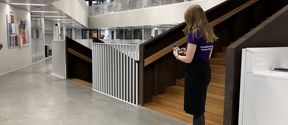Developing parking at Otaniemi campus
The event was the second open discussion event. The topic has been reviewed by the Cooperation committee and the working committee of the Professors’ Council.
Various changes are needed to develop parking in Otaniemi. Aalto University is looking improve the overall user experience of car parking, while ensuring that land use is in line with the principles of sustainable development. Our developing campus requires a modern take on parking as well.
Parking fees and parking control
Most questions raised by the audience were concerned of the payload of car parking, but the technical implementation of parking control was a hot topic. Implementing parking fees are not based on a certain ideology, but rather on how to cover the cost of parking.
Currently, the university subsidizes car parking fees, while other forms of transportation are not subsidized. The amount of the fee will be based on cost calculations to determine what is a fair share of parking fees for the university and what is a fair share for the users.
A parking application would use a use-base charge and potentially set up a demand-based tariff instead of a fixed fee. For example, web application Otapark makes it easier to locate a parking space. At the same time, the university can receive real-time information on the demand and supply of parking places and can then avoid the construction of new and expensive parking spaces. Saved funds can thus be used towards teaching and research.
New buildings will be built on existing ground-level parking areas as the development of our campus continues, so we must build replacement parking facilities that are more expensive to build than previously constructed landfills. For example, after Väre, School of Business, A Bloc and Aalto Studios are completed, 500 parking spaces will be lost.
Timetable and pilot
No decision has yet been taken on the parking charge for parking. More detailed guidelines will be made after the principle decision. The guidelines will be discussed further with the staff representatives. The timetable will only be refined after the principle decision. In any case, the timing of the change will be synchronized with the city of Espoo, Senate Properties and VTT. ACRE is currently conducting a variety of cost scenarios for car parking.
The change would come into force gradually. In the first phase, guidance and support will be developed, and at the same time a small, free of charge pilot will be launched. It will then be possible to extend the pilot to cover the whole campus, still remaining free of charge for the users during the pilot phase. Pilot trials will be used to gather user experiences and to potentially map the cost structure of parking.
Try the Otapark parking application and give feedback: otapark.fi
Presentation from the event: Smart Car Parking Seminar 2
Questions and answers raised in the discussion (updated):
Have you considered whether there will be free parking spots along with charged parking?
A: There might be different tariff areas. One option is to have some free of charge parking spots as well.
If we go to web-based control, how exactly is it done?
A: The city of Espoo has a system for knowing whether or not this registration number has been paid. With the parking control of the City of Espoo, it has been negotiated the possibility of introducing a system in which the parking assistant can check the parking number for the parking number if the parking fee is paid.
What if someone uses more than just one car?
A: It is possible to register multiple vehicles with the Otapark parking application.
If you shouldn’t use a mobile phone while driving, how can a mobile application be used for parking?
A: The application provides a map view that could be viewed without touching it. It displays parking information in different colours but does not give information on an individual parking place. To park successfully, press the "start" button and stop your park time by pressing the "stop" button.
Staff have flexible working hours. How does pricing reflect the staff not using their cars every day?
A: For example, a sticker not suitable to charge for only actual use, which would support the move to smart parking.
How much parking space will there be available in the future?
A: In new schematic modifications, the parking spot has been changed from 1/90 or 1/120 to 1/200, which reduces the amount of new parking spaces but certain measures have been agreed with the city of Espoo regarding this as well. Parking rates must be monitored in order to build parking spaces to meet the needs of the users. However, the purpose of the university is not to invest in additional parking spaces.
How will the requirements of the GDPR (European Data Protection Regulation) be taken into account? Would the parking application monitor work hours?
A: The parking application does not track working hours or register any unnecessary data.
Can you make sure there are enough places available to the staff members who arrive later?
A: The goal is to have enough places for everyone.
Is it possible that, for example, our visitors would use Easypark or Parkman?
A: Technically yes, but the question is whether we want to give half of the parking fees to a third party if the goal is to build a rational cost model. The Otapark application also guides the visitor to park in a vacant location at the target building. Easypark or Parkman do not offer finding a parking space nor do they track the use rate.
How are the zone prices taken into account? And what about commercial actors? Are they involved in the change?
A: Merchants pay for some places to get them free of charge to their customers. For example, A Bloc will have some short-term parking spaces that are intended for customers of the stores.
Camera recognition would be a better option and the mobile phone is by no means a modern user interface.
A: Camera recognition is available and its suitability has been tested but is not yet on a reliable level. We want to be pioneers, but at the same time we cannot introduce expensive experimental parking controls.
If the electric cars become a big hit, do we have the capacity for the necessary infrastructure for charging points?
A: It’s possible to add this capability and these can also be linked to the parking application so that the places with charging points can be priced differently. The number of charging points is still open.
If there is a fixed fee, it will diminish the use of other forms of transport as one already pays a monthly fee. What about those members of staff who use their own vehicles to transport items for the university?
A: The University pays for car parking when it is done work purposes, like in situations described here.
If I currently have parking sticker paid by my employer and then in the future I have to pay for it myself, then is this in line with the YT procedures?
A: The issue has been dealt with eg. the Cooperation Committee, and in these two open discussion sessions. The guidelines will also be discussed in future with the staff representatives.
Will other forms of transportation be subsidized in some way?
A: Aalto University will introduce a chartered ticket during this year, whereby the university will subsidize commuter travel on public transport by personnel under contract at EUR 10 per month. There will be further information regarding this after the summer holidays.
When will the pilot be ready to start?
A: Readiness to start soon enough, maybe already in the summer.
Could more parking space be built underground?
A: The soil in Otaniemi is both rocky and clayey. Rock excavation is quite challenging, so the cost of an individual parking lot would increase significantly compared to building parking spot on ground. Clayey soil would need a trough or a similar construct to protect the car park in order to keep the water away. We would then need to take advantage of already existing tunnels but transforming them into parking lots is by no means profitable.
Read more news

Call for Applications: Aalto Creatives Pre-incubator Programme Spring 2026
Join the Aalto Creatives afterwork and info session on 20.1.2026 to find out more about the open call and meet the Aalto Creatives team. At this event, alums from the pre-incubator tell about their entrepreneurial journeys and share their experiences from participating in the AC programme.
Stay safe near metro stations
When walking on the streets, it is crucial to stay alert to avoid being scammed.
Temporary traffic arrangements on Lämpömiehenkuja and Metallimiehenkuja
The new arrangements will be implemented starting Monday, November 24, 2025.






